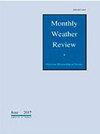Radar-derived Convective Features and Atmospheric Environments of Hail-Producing Storms over the Contiguous United States
IF 2.8
3区 地球科学
Q3 METEOROLOGY & ATMOSPHERIC SCIENCES
引用次数: 0
Abstract
Hail smaller than 0.75 inch is known to cause economic impacts yet remains understudied due to report biases towards recording larger hail sizes (≤1 inch). In this study, we assembled ground hail reports during 2017-2022 from the National Centers for Environmental Information (NCEI) Storm Data, Community Collaborative Rain, Hail and Snow Network (CoCoRaHS) and Meteorological Phenomena Identification Near the Ground (mPING) databases. Then these reports are collocated with the attributes of radar-derived convective features from the Multi-Radar/Multi-sensor System (MRMS) and the European Centre for Medium-Range Weather Forecasts Reanalysis v5 (ERA5) atmospheric vertical profiles to construct a dataset describing properties of a full spectrum of hailstorms. The characteristics of radar reflectivity and atmospheric profiles are examined for hail of different sizes reported within selected regions over the Contiguous United States (CONUS). In addition to the seasonal and diurnal variations, the morphology of convective features shows apparent regional differences from west to east in CONUS. The Maximum Expected Size of Hail (MESH) performance against reported hail sizes shows underestimation of hail with significant sizes, and overestimation of small hail sizes. ERA5 vertical atmospheric profiles are explored to form relationships between storm environment and hail sizes. In addition to the relationships between wind shear and hail sizes, the roles of low-level relative humidity and freezing level height in regard to hail melting are discussed.美国大陆上空产生冰雹风暴的雷达对流特征和大气环境
众所周知,小于 0.75 英寸的冰雹会造成经济影响,但由于报告偏向于记录更大尺寸(≤1 英寸)的冰雹,因此对冰雹的研究仍然不足。在这项研究中,我们从国家环境信息中心(NCEI)风暴数据、社区雨雹雪协作网络(CoCoRaHS)和近地面气象现象识别(mPING)数据库中收集了 2017-2022 年期间的地面冰雹报告。然后,将这些报告与来自多雷达/多传感器系统(MRMS)和欧洲中期天气预报中心再分析 v5(ERA5)大气垂直剖面的雷达衍生对流特征属性进行比对,以构建一个描述全方位冰雹特性的数据集。针对美国毗连地区(CONUS)选定区域内报告的不同大小的冰雹,研究了雷达反射率和大气剖面的特征。除了季节和昼夜变化外,对流特征的形态也显示出美国大陆从西到东的明显区域差异。冰雹最大预期尺寸(MESH)性能与报告的冰雹尺寸相比,显示出对大尺寸冰雹的低估和对小尺寸冰雹的高估。除了风切变与冰雹大小之间的关系外,还讨论了低层相对湿度和冰冻层高度在冰雹融化方面的作用。
本文章由计算机程序翻译,如有差异,请以英文原文为准。
求助全文
约1分钟内获得全文
求助全文
来源期刊

Monthly Weather Review
地学-气象与大气科学
CiteScore
6.40
自引率
12.50%
发文量
186
审稿时长
3-6 weeks
期刊介绍:
Monthly Weather Review (MWR) (ISSN: 0027-0644; eISSN: 1520-0493) publishes research relevant to the analysis and prediction of observed atmospheric circulations and physics, including technique development, data assimilation, model validation, and relevant case studies. This research includes numerical and data assimilation techniques that apply to the atmosphere and/or ocean environments. MWR also addresses phenomena having seasonal and subseasonal time scales.
文献相关原料
| 公司名称 | 产品信息 | 采购帮参考价格 |
|---|
 求助内容:
求助内容: 应助结果提醒方式:
应助结果提醒方式:


